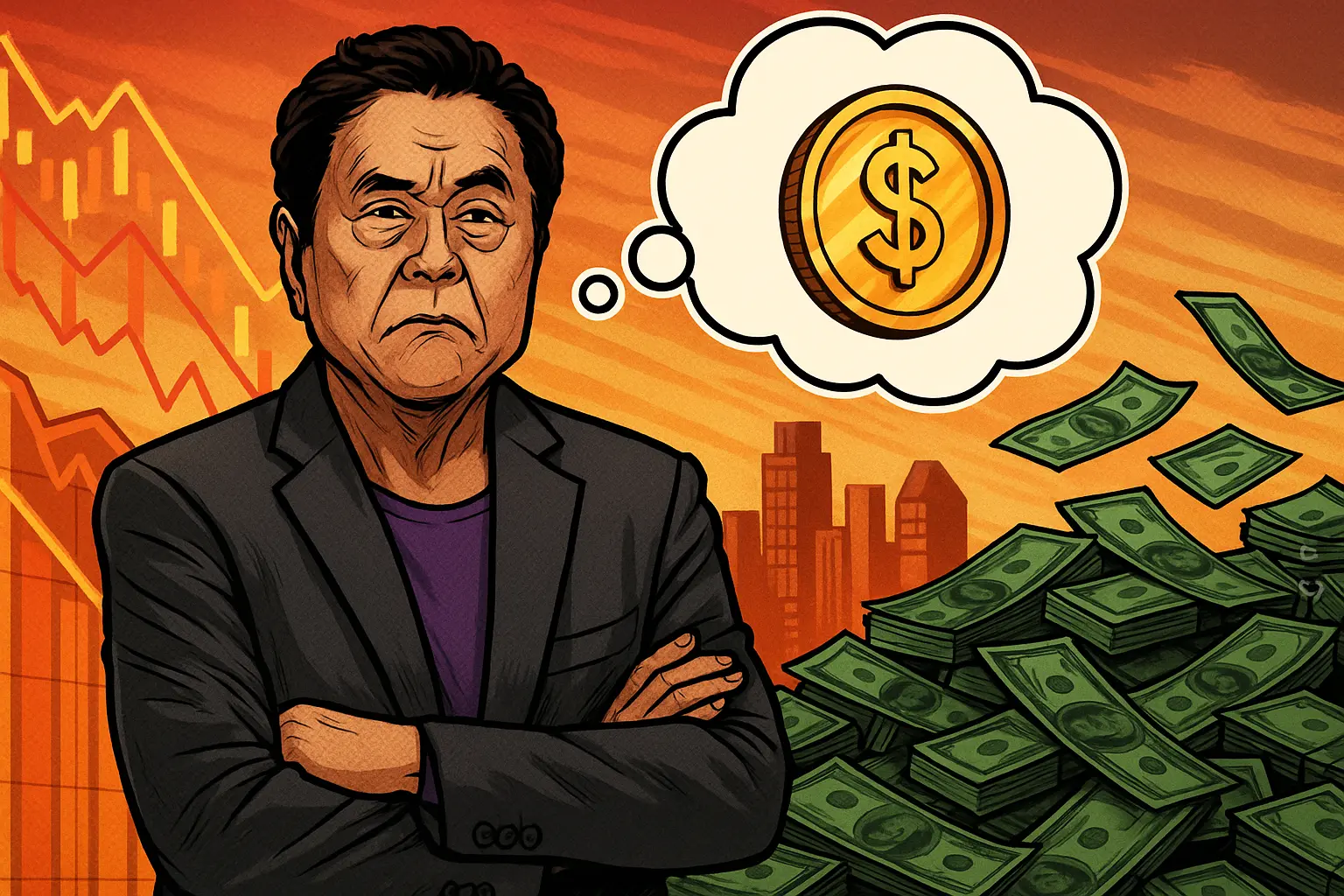Robert Kiyosaki is everywhere—bookshelves, Twitter, YouTube, and the seminar circuit. He’s loud, relentless, and always selling the same message: “The biggest financial crash in history is imminent. Only gold, silver, and Bitcoin will save you.”
For more than two decades, he’s made a fortune stoking anxiety and selling apocalyptic solutions. But what’s behind the constant drumbeat of doom? Is his financial advice really about protecting you—or is fear itself the product?
The Genesis of a Guru: From “Rich Dad” to Doom Prophet
Kiyosaki burst onto the financial scene with “Rich Dad, Poor Dad” in 1997—a book that sold over 41 million copies and became a rite of passage for a generation of would-be investors. The core message was seductive: “School won’t make you rich. Jobs make you poor. Only investing—preferably in real estate and gold—offers true financial freedom.”
But even his bestseller was built on shaky ground. The two father figures at the heart of the story? Entirely unverifiable—and by many accounts, fictional. Critics like John T. Reed called the book “a motivational fable at best.” Financial columnist Helaine Olen put it even more bluntly: “His tips range from ridiculous to illegal to potentially harmful.”
The Business of Doom: How Constant Crisis Creates Customers
Since the early 2000s, Kiyosaki’s worldview has become increasingly radical. Gone is the moderate skepticism about school or jobs; in its place, a perpetual state of emergency. Every year brings a new collapse: the dollar, the banks, the government, the baby boomers. In Kiyosaki’s universe, Armageddon is always just around the corner.
- 2008: “The US financial system will implode. Gold will save you.”
- 2012: “Hyperinflation is coming. Buy silver.”
- 2020–2025: “The biggest crash in world history is imminent. Only Bitcoin, gold, and silver offer safety.”
And yet, time and again, his dire predictions fail to materialize. After the dotcom bubble, markets boomed. The S&P 500 climbed by more than 500% after the 2008 crisis. Tech stocks like Apple, Amazon, and Google achieved record-breaking growth. Even the pandemic crash of 2020 saw a swift V-shaped recovery. Investors who followed Kiyosaki’s advice—fleeing stocks for “safe havens”—missed out on some of the greatest wealth-creation opportunities in history.
BUBBLES are about to start BUSTING.
— Robert Kiyosaki (@theRealKiyosaki) July 21, 2025
When bubbles bust odds are gold, silver, and Bitcoin will bust too.
Good news.
If prices of gold, silver, and Bitcoin crash…. I will be buying.
Take care.
The Real Cost: How Fear-Based Advice Destroys Wealth
The danger isn’t just in bad predictions—it’s in the opportunity cost of living in fear. When investors are convinced that a crash is always imminent, they stay on the sidelines, miss out on market growth, and often make panic-driven moves that lock in losses. Psychological research confirms: Loss aversion and fear-based decision-making are among the fastest ways to destroy long-term wealth.
A recent Brew Markets analysis compared Kiyosaki’s public forecasts to actual S&P 500 performance. The result: those who took his advice missed out on hundreds of percent in gains. Even mainstream media—from Forbes to MarketWatch—have sounded the alarm: “Don’t take investment advice from Robert Kiyosaki.”
The Sales Machine: Seminars, Upselling, and the Business of Anxiety
Kiyosaki’s real genius isn’t in financial strategy—it’s in marketing fear. His empire is built on books, podcasts, paid newsletters, online academies, and ultra-high-ticket seminars. Some “elite” coaching packages in the US have cost up to $42,300 per attendee.
- Aggressive upselling: Free events often serve as funnels for expensive follow-ups.
- Opaque pricing: Many customers only discover the real costs after committing.
- Pressure tactics: “Act now before it’s too late!” is a core message.
- Legal trouble: Investigative reports by ABC, CBC, and CBS exposed fines totaling over $690,000 for misleading practices.
His core product isn’t investment knowledge—it’s hope and fear, monetized at scale. The real “crash” is what happens to the financial health of those who buy into the perpetual state of emergency.
Bitcoin, Gold, Silver: Salvation or Speculation?
Kiyosaki’s mantra—“Gold is God’s money. Silver is the money of the poor. Bitcoin is real money.”—is catchy but simplistic.
- Bitcoin is volatile, not legal tender in most countries, and faces constant regulatory risk. Its price can swing by 20% in a single week.
- Gold and silver don’t produce cash flow, are cumbersome to trade, and often lag behind inflation in real terms.
Blindly following such advice means ignoring core principles like diversification, asset allocation, and rebalancing. Data shows that well-diversified portfolios—mixing ETFs, stocks, real estate, and only modest exposure to precious metals or crypto—deliver far better risk-adjusted returns.
Kiyosaki’s “one-asset-saves-all” mentality is not only dangerous—it’s fundamentally at odds with how real wealth is built. In reality, markets are cyclical, and the only consistent winners are those who stay diversified and invest with discipline.
The Psychology of Panic: Why People Fall for Doom Narratives
Why do so many smart people fall for the same crash narrative again and again? Psychologists point to powerful emotional triggers:
- Loss aversion: People hate losing money more than they like making it.
- Recency bias: Recent crashes (like 2008 or 2020) stick in memory, fueling anxiety.
- Authority bias: Big claims from bestselling authors sound credible—even if unsupported.
Kiyosaki’s entire brand is built on amplifying these fears, then offering expensive “solutions.”
Critical Thinking: The Antidote to Financial Prophets
Should you ignore all market risks? Of course not. But history is clear: Those who panic, sell low, and chase apocalyptic headlines consistently lose out. The most successful investors diversify, stay invested, rebalance, and think long-term—even in turbulent times.
Kiyosaki deserves credit for getting millions to question their financial habits. But his playbook has shifted from financial education to fear-based marketing. The real winners are not those who pay for another seminar—but those who do their own homework, invest rationally, and refuse to let fear dictate their future.
Don’t let doom prophets rent space in your head—or your portfolio.




